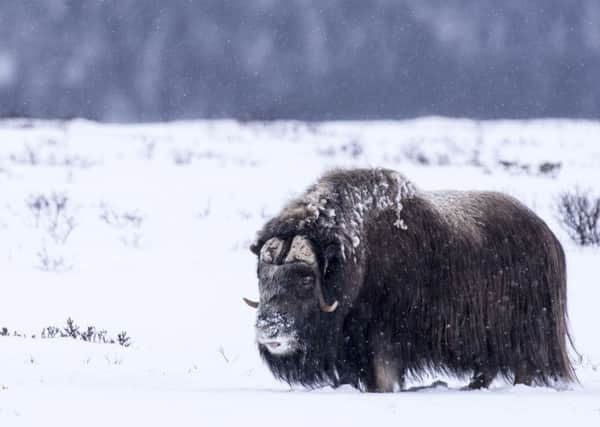Travel review: Dovrefjell National Park, Norway


Implausible as it may seem, it is possible to overheat in temperatures of minus 10C. I discover this while heaving up a steep-sided valley in Norway’s Dovrefjell National Park, smashing my racket-shaped snowshoes against the indomitable terrain.
We’ve been trekking for three hours, spiralling through brittle, life-drained forests and over smooth, snow-blanketed granite mounds, in search of the park’s enigmatic but dangerously volatile resident: musk ox.
Advertisement
Hide AdAdvertisement
Hide AdRoughly 260 of these ancient Arctic mammals graze here year-round, sweeping the mountains with a scraggy mass of unkempt hair and mopping up lichen, moss and grass in the process. Contemporaries of the woolly mammoth, their resilience is remarkable; they’ve weathered ice ages, human hunting and disease. But this Norwegian community is much younger. In the 1920s, musk oxen bones were discovered during the railroad construction in nearby town Oppdal, suggesting conditions would be favourable for their reintroduction.


Ten animals were shipped from Greenland in the 1930s, although most were shot and eaten during the Second World War. However, a second group successfully settled between 1947 and 1953, and were largely ignored by science.
Twenty years ago, Johan Schonheyder from Musk Ox Safari began guiding tourists to see the Bovidae beasts. Most come in summer, when clement weather makes hikes much easier and females come down to the river Driva to give birth, but winter visits are on the rise.
A day earlier, I’d arrived in Trondheim, the entry point to Norway’s central Trondelag region, and the country’s former Viking capital. Colourful clapperboard stilt houses draw visitors to 18th century wharves on the river Nidelva, a short walk from Nidaros Cathedral, built on the burial site of national hero St Olav. Trondelag is also Norway’s wild region, where hunters have thrived for centuries and untamed animals continue to prosper, and a two-hour drive along the E6 soon leads me to Oppdal.
Advertisement
Hide AdAdvertisement
Hide AdDespite the strenuous climb, good visibility is a boon on day one of our March musk oxen safari. But by the time we find our quarry – a herd of 27 animals with a six-month-old calf – it’s already late and buttercup streams of sunlight are stretching out our shadows.


In reality, in winter, stubborn musk oxen don’t do very much. “They could remain in this position for two weeks,” warns Johan, a wiry Norwegian in his later years whose athleticism shows no signs of abating.
Knowing we have a second stab at finding them the following day, we ride home on fading rays of daylight.
Silky pinks segue into baby blues, embracing the frozen landscape in a cool hug. Polar fox tracks trace an irresistibly pristine blank canvas, pockmarked with snow-holes dug by shelter-seeking grouse.
Advertisement
Hide AdAdvertisement
Hide AdJohan tells me some of his guests do the same, overnighting in expedition sleeping bags. The prospect of avoiding another long hike is appealing – but so too is a toasty log cabin with a roaring hearth. Made with reclaimed wood from ancient farmhouses, Bjerkelokkja is a complex of self-catering, grass-roofed cabins, an hour’s drive from the park.
Matches struck, I snuggle into a sheepskin-draped rocking chair, listening to ravenous flames gasp and gorge on dry wood. Candlelight licks the windowpanes as I watch stars blaze like wildfire across the gaping charcoal sky.
The next day there’s news a group of musk oxen have been spotted closer to the road, and with a dog, Tell, to drag our belongings in a pulk (sled) the hike promises to be less arduous. We find four males bunched defensively in a bachelor group. But as we slowly edge closer they relax and disperse, although a steady gaze tracks our every movement. Coats matted with clumps of waxy yellow ice and brows dusted with frost sparkles, they look every bit the Arctic explorer.
Sinking deeper into my puffy down jacket, with a Thermos of coffee, I watch with admiration, wondering how these stoic creatures have managed to exist for millennia.
GETTING THERE
Advertisement
Hide AdAdvertisement
Hide AdSarah Marshall was a guest of the Norwegian tourist board. For more information on Norway, go to visit norway.com, and for Trondelag, en.trondelag.com
A one-day winter musk ox safari with private guide costs from £217pp (based on two participants). A maximum of four people can join a private group, reducing the cost to £108.50pp. Visit moskussafari.no
One night at Bjerkelokkja (bjerkelokkja.no) costs from £132pp.
Norwegian (norwegian.com/uk) operates flights from London Gatwick to Trondheim five times per week, from £41.90 one way.